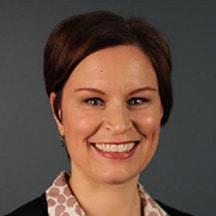The Real Deal

au.then.tic branding
/ô THen(t)ik/ /brandiNG/
The extent to which consumers perceive a brand to be faithful toward itself, true to its consumers, motivated by caring and responsibility, and able to support consumers in being true to themselves.
— The Journal of Consumer Psychology
As many organizations break their silence and take stances on social issues, honesty and transparency with members is more important than ever before. Even for organizations with established reputations and brand equity, if members don’t feel represented, included and a part of the mission, nothing else really matters.
For the American Academy of Pediatrics (AAP), acheiving authentic branding meant taking their nearly 100-year-old trusted reputation and elevating it to become a brand that makes members feel seen and heard — a success that is reflected in engagement and retention.
Path to a Blueprint
Based in Itasca, Illinois, the AAP has been the voice of pediatricians, pediatric medical subspecialists and pediatric surgical specialists since its inception in 1930.
“The AAP is recognized as one of the most expert and influential organizations on all matters related to child health,” says Tina Morton, the director of member marketing and engagement for the AAP. Most notably through education, advocacy and public policy, the AAP works to accomplish its mission of achieving optimal physical, mental and social health and well-being for all infants, children, adolescents and young adults. As for the benefits its 67,000 members most highly rate, education, policy and guidelines top the list.

The American Academy of Pediatrics (AAP) began using a form of their Della Robbia in 1930. It was inspired by the medallions designed by Andrea della Robbia (1437–1528) that decorate the “Ospedale degli Innocenti,” or foundling hospital of the innocents, in Florence, Italy. It’s the oldest known institution continuously devoted to the care of children, according to the AAP.
When it comes to imagery, the AAP’s brand has always been closely tied to its symbol — the Della Robbia — a seal depicting a young child loosely wrapped in a swaddle. Instantly recognized by professionals in the field, “this seal evokes feelings of credibility and accuracy,” Morton says.
Despite this brand equity and respected reputation, the AAP had room for improvement when it came to connecting with members. So, in 2013 when Morton began her job at the AAP, the journey to more authentic branding began.
Among her first pursuits was leading the membership marketing team in a visual rebrand for all membership communications.
“We took everything and put it on a table,” Morton says. “We looked at print and digital — all the mastheads, emails, brochures and Facebook pages — and we asked, ‘Does everything match?’ What we saw was that the team was taking different approaches. There was no clear scheme.”
To develop a distinct visual plan, the AAP enlisted Culture 22, a brand storytelling agency. “They did a bunch of interviews and activities with our members. They put out toys and sophisticated mood boards and observed our members interacting with them to get an overall feel for what our members like,” she says.
This research helped inform the brand’s font style, color palette and the design behind photography.
Know Thy Member
With a solid visual aesthetic in place, AAP partnered with marketing consulting group Avenue M to survey members and establish a baseline understanding of member satisfaction and goals. “AAP had not done a comprehensive member assessment in a while, so I needed to establish this for the bulk of my work,” Morton says. “We looked at every membership benefit and asked, ‘How important is it to you, and how well are we delivering it?’”
The survey results were enlightening — highlighting weaknesses and presenting a clearer description of their members.

Tina Morton, director of member marketing and engagement, AAP
“It not only helped us get a feel for demographics, but it helped us recognize different member personas,” Morton says. For example, they identified a mission-driven member persona that joins because they believe in doing good. Another segment is transactional, joining for the member benefits they get in return. Yet another segment wants to be very engaged, interested in what can they do to help.
But, until now, the Academy had been communicating with these different groups the exact same way.
“Every member was getting the same message, and it wasn’t effective,” Morton says. Learning about the personas allowed the marketing department to be more thoughtful about their messaging. Now, the Academy creates multiple versions of each membership communication, whether it is an email message or a paper dues invoice, to make sure they are hitting the right tones.
The survey also gave them insights into why membership numbers for subspecialists, such as pediatric cardiologists or pediatric gastroenterologists, were declining. Sentiments showed that subspecialists felt that the AAP was geared more toward generalists than them. The results also revealed why subspecialists did join the Academy — to participate in AAP Sections (interassociation communities of like-minded professionals), education development and policy reviews — and it allowed for another opportunity for tailored messaging.
“We determined which words in email subject lines get better click rates with subspecialists, so now subject lines that go to subspecialists are different than the subject lines to generalists,” she says. “And we’ve greatly improved our retention and recruitment rates with subspecialists.”
The Academy implements similar tailored messaging through social media, with one Twitter feed and two Facebook pages — one for trainees and one for early career physicians.
“We get a ton of engagement on social media whether it’s advocacy, a call to action or a tweetstorm to impact legislation,” Morton says.
A Thousand Words
Along with specific messaging and visual consistency, the photos and images used in membership marketing materials also needed revamping.
“The survey revealed that the visuals we were using were not reflective of members’ experiences,” she says, explaining that prior to the survey, the Academy had been using many images of babies on the marketing materials.
“Members indicated they preferred to see themselves and other pediatric physicians with infants, children and adolescents. They also want to see diversity, including children with disabilities and special needs — all of the children they take care of on a daily basis,” Morton says.
To restock their supply of images, Morton and her team hired a professional photographer and invited members to have their photos taken with the children of AAP staff.
“We showed the members as the hero, in the center of our brand,” Morton says. “We said, ‘You ARE our brand,’ and it showed the AAP and its members are one and the same.”
First appearing in printed and online membership collateral, the larger unveiling of the campaign was at the annual AAP Experience, the National Conference and Exhibition, and has been used at all conferences since. Morton says members take photos next to their own poster-sized images or with their photo in brochures.
At last year’s conference, these photos were featured on huge banners that simply said, “Thank you.”
Now they have a robust in-house bank of stock photos, which they encourage all departments of the AAP to use.
A Welcoming Brand
Creating a Welcoming Environment® has long been a priority of the AAP, which has sections on LGBTQ health and wellness, as well as diversity and inclusion. But even with these opportunities in place, member engagement was lagging.
The American Academy of Pediatrics has one goal in mind — ensuring the safety and health of children. Because of this, the Academy has long been an outspoken advocate on a variety of social issues.
Whether speaking in favor of gay marriage or fighting against racism, the AAP provides studies and data about the impact on children and works to be a change agent.
“The AAP is known for taking a stand and coming out with a statement,” Morton says. “The single driving motivation for any stance we take on any issue is: ‘What is best for children?’”
“We have been perceived as an organization that is hard to penetrate,” Morton says. The survey revealed three main reasons why members weren’t engaging:
- They weren’t asked
- They didn’t know how
- They didn’t have a lot of time
The survey then asked if they would engage if they were asked, and the answer was overwhelmingly, “yes.”
“And if they were engaged, the majority responded that they were more likely to renew,” Morton says.
These findings led them to launch the AAP Volunteer Network Online portal, where members can search for volunteer opportunities using a variety of filters to find the perfect fit. “We want to help members see this environment is for everybody.”
COVID-19 Updates
Knowing your members also means constantly listening and being ready to pivot. As timing would have it, AAP’s renewal campaign was planned to launch right as the coronavirus numbers were peaking.
“COVID-19 really kind of turned everything upside down,” she says. “We were getting some backlash around our messaging and communications. Members were sending these back to us saying, ‘Why am I getting this when were dealing with this crisis?’”
“We met with the team and made the decision to stop all recruitment and put a pause on the renewal process — but not for too long because that’s our bread and butter.
“We rewrote all the renewal messages. It was a series of eight or nine touches via print and email. The first four or five don’t even have a call to action; they just offer resources and say simply, ‘We’re here for you.’” Then the campaign slowly offers a subtle call to action to renew. If the membership lapses, the member still gets key benefits for 60 days. And even after 60 days, if the member is not able to pay dues, they can talk about waiving dues for a year. “Once we switched to that messaging, we got absolutely no blowback,” says Morton, who personally responded to every complaint received.
Recruitment did not resume again until late June, but Morton says they would remain nimble, and if messaging isn’t right, they will quickly tailor it.
Measuring Success
Morton says the ways the Academy measures success are two-fold. “Obviously, there are metrics like regular emails opened, sales tactics and campaign results. But for measuring branding success, it’s the things like members taking their picture by their face when they see it on a sign at the conference; it’s using their Fellow of the American Academy of Pediatrics (FAAP) credential after their name; it’s when they call and ask if they can use our logo. It’s international members joining even though it’s a U.S.-based organization.”
Currently working on a digital transformation to improve user experience, Morton says the AAP will work hard to maintain their authenticity.
“For our membership, authentic branding means that when they see our Della Robbia, they know it is credible, ethical and driven by the main goal of improving children’s health globally. It will never change, and we will not stray from that,” Morton states.
She adds that all of the improvements — from the visual aesthetic and more energetic tone of voice to members seeing themselves represented in the messaging — have contributed to their authenticity. 
- Define your branding mission. How do you want your audience to feel? What comes over them when they see your visuals or letterhead? What is the first thing they think of when they see it? Brainstorm and write those words down.
- Create your visuals. Using the words you brainstormed when you defined your mission, let them lead you to the visuals that you would use. Your goal is to take that feeling and execute it.
- Survey your members. Start by understanding the current impression members have. Ask, ‘When you hear our name what comes to mind?’ You may already have good brand equity, and you just need to leverage it. Or if maybe you don’t, then it’s about shifting brand perception, and that means taking a different approach.
- Work with a talented agency. Tap into the expertise of agencies whose business is branding. AAP worked with two — Culture 22 and Avenue M — during their process. “We worked with Culture 22 for the visual overhaul. They helped establish colors, font — the visual aesthetic. Avenue M assisted in conducting our member survey.”
- Never stop listening. Just because your have strong branding does not mean your work is done. Authentic branding only exists if your members are on board, so if they express displeasure, it’s time to act. When a recent renewal campaign during COVID-19 upset some members, the AAP team quickly revamped their messaging with a more empathetic — and successful — approach.
Tags
Related Articles
Celebrating Hispanic Heritage Month with Association Latinos
How to celebrate Hispanic Heritage Month within the association community and Chicago!
Tips for Creating a Welcoming Meeting Environment
Creating a truly inclusive annual meeting means going beyond ADA compliance—discover how one association builds...
POV: My First Time at Women’s Executive Forum™ Was Inspiring and Invigorating
A first-time attendee of the Women’s Executive Forum 2025 reflects on the event’s inspiring energy,...




